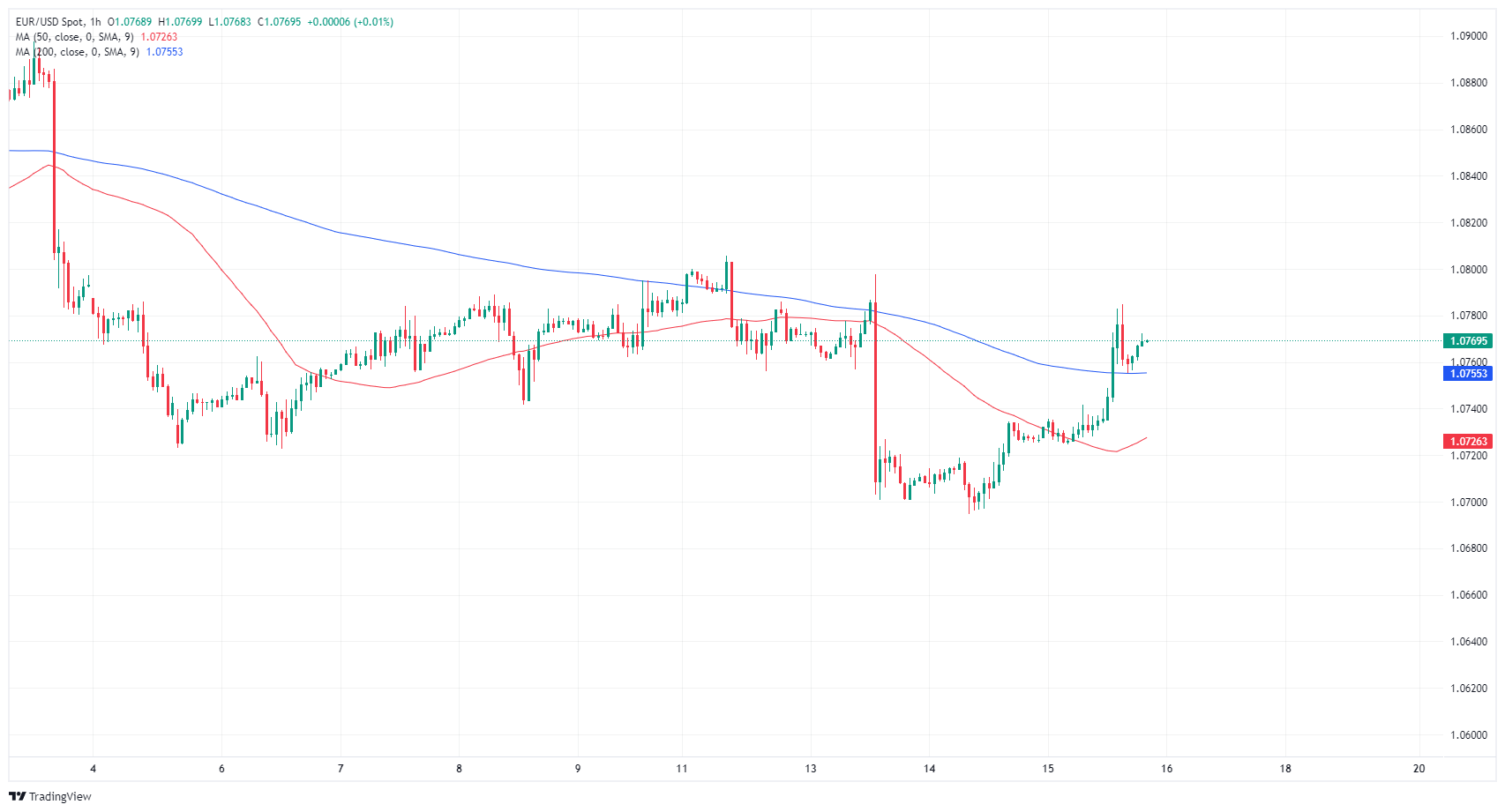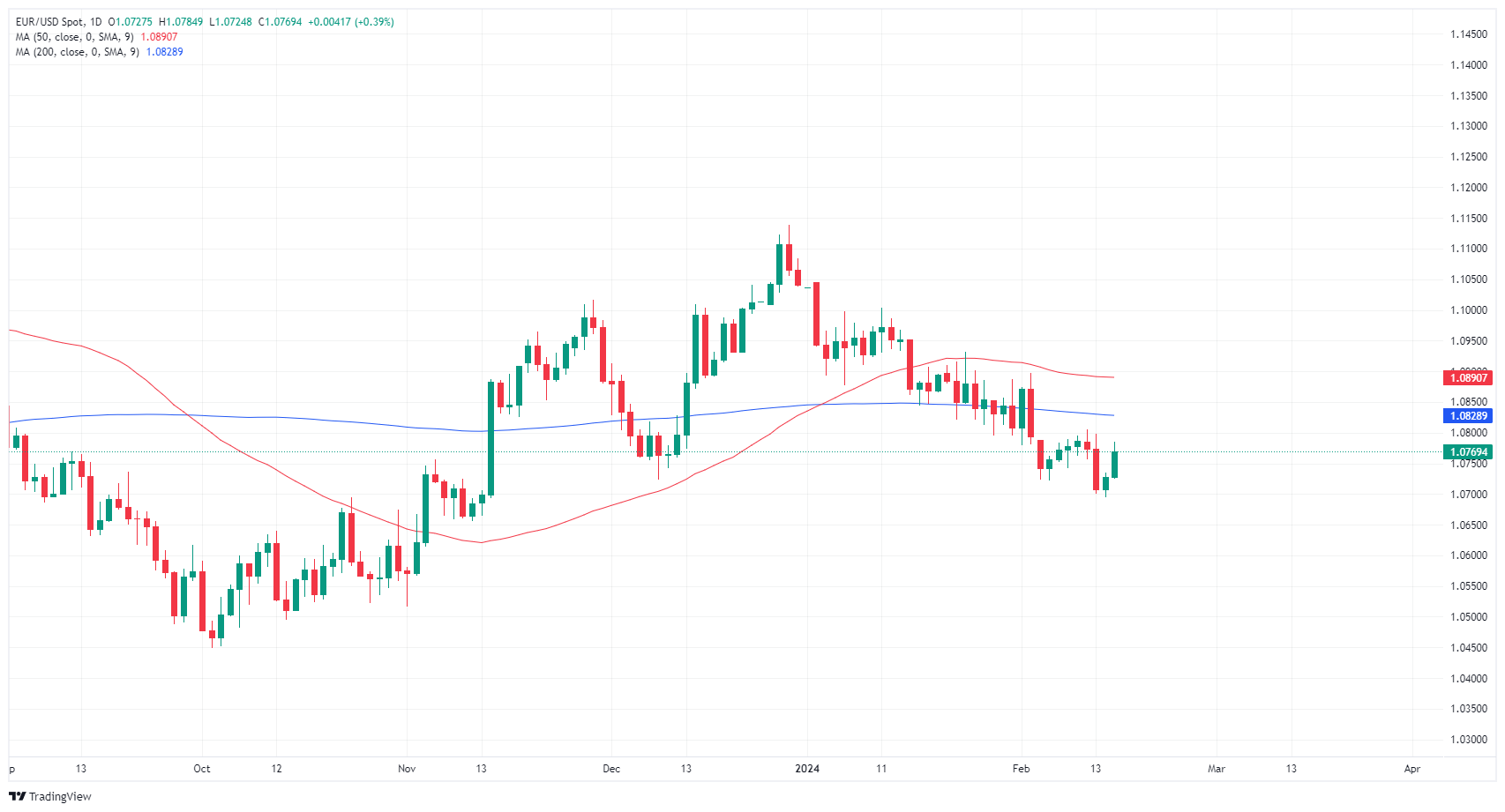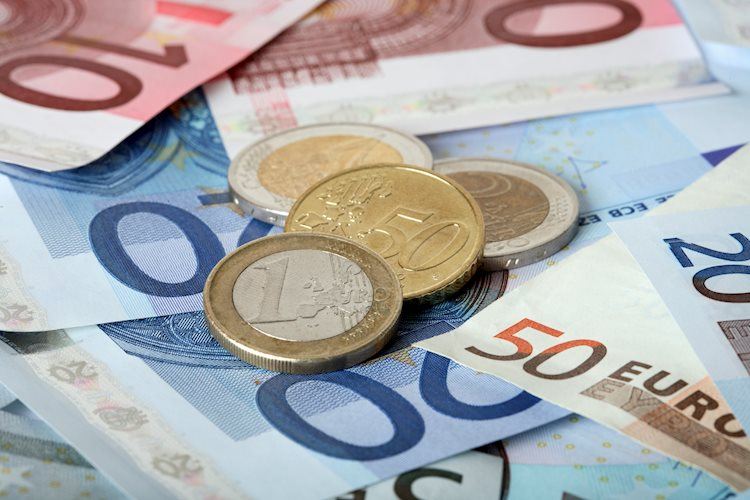- US Retail Sales missed the mark on Thursday, driving down the US Dollar.
- The Euro caught a leg up, putting more distance above the 1.0700 handle.
- Friday wraps up the trading week with US PPI figures, Michigan sentiment survey.
EUR/USD gained ground on Thursday, extending a rebound from the 1.0700 handle after the pair flubbed technical levels earlier in the week. The European Commission revised down its Economic Growth Forecasts, and US Retail Sales showed an unexpected contraction in consumer spending activity.
Daily digest market movers: EUR/USD pares recent losses as investors pivot on US Dollar
- US Retail Sales shrank 0.8% MoM in January, well below the -0.1% forecast compared to the previous month’s 0.4% (revised down from 0.6%).
- US Core Retail Sales (excluding Automobiles) also declined 0.6% in January, reversing the forecast 0.2% uptick compared to December’s 0.6% (revised 0.8%).
- Investors hungry for rate cuts from the Federal Reserver (Fed) dog-piled on the US data miss, as a softening US economic landscape increases odds of a Fed rate trim.
- US Initial Jobless Claims came in below expectations, printing at 212K for the week ended February 9 versus the forecast 220K.
- The previous week’s Initial Jobless Claims also saw a revision to 220K from 218K.
- The European Commission lowered economic growth projections for the euro area and the broader European economy.
- The European Commission expected pan-EU growth to hit 0.9% through 2024, with annual growth for the euro area to see only 0.8%.
- Economic growth is expected to tick back up in 2025, with the EU expected to see 1.7% growth with the euro area trailing with 1.5% overall growth.
- Pan-EU HICP inflation is forecast to settle to 3.0% in 2024 and 2.5% in 2025, down from 2023’s 6.3%.
- Friday’s US Core Producer Price Index (PPI) is forecast to tick down to 1.6% from 1.8% for the year ended in January.
- The Michigan Consumer Sentiment Index is expected to improve slightly to 80.0 from 79.0.
Euro price today
The table below shows the percentage change of Euro (EUR) against listed major currencies today. Euro was the strongest against the US Dollar.
| USD | EUR | GBP | CAD | AUD | JPY | NZD | CHF | |
| USD | -0.35% | -0.23% | -0.50% | -0.36% | -0.39% | -0.33% | -0.61% | |
| EUR | 0.35% | 0.10% | -0.15% | -0.01% | -0.04% | 0.03% | -0.25% | |
| GBP | 0.24% | -0.12% | -0.27% | -0.13% | -0.16% | -0.10% | -0.37% | |
| CAD | 0.50% | 0.15% | 0.25% | 0.14% | 0.11% | 0.17% | -0.10% | |
| AUD | 0.38% | 0.00% | 0.14% | -0.14% | -0.03% | 0.04% | -0.25% | |
| JPY | 0.39% | 0.05% | 0.15% | -0.11% | 0.02% | 0.05% | -0.22% | |
| NZD | 0.33% | -0.03% | 0.10% | -0.17% | -0.03% | -0.06% | -0.28% | |
| CHF | 0.61% | 0.26% | 0.38% | 0.12% | 0.26% | 0.22% | 0.29% |
The heat map shows percentage changes of major currencies against each other. The base currency is picked from the left column, while the quote currency is picked from the top row. For example, if you pick the Euro from the left column and move along the horizontal line to the Japanese Yen, the percentage change displayed in the box will represent EUR (base)/JPY (quote).
Technical analysis: EUR/USD finds chart ground above 1.0755
EUR/USD rose on Thursday, extending a recovery from the midweek’s decline into the 1.0700 handle, paring back recent losses and scrambling back over the 200-hour Simple Moving Average (SMA) at 1.0755.
The pair briefly tested 1.0785, and the EUR/USD remains bid into near-term bullish territory but remains down from the last swing high into 1.0800.
Despite an intraday recovery, the EUR/USD is still on the bearish side of the 200-day SMA near 1.0830, and the pair is still down 3.3% from December’s peak bids at 1.1140.
EUR/USD hourly chart
EUR/USD daily chart
US Dollar FAQs
The US Dollar (USD) is the official currency of the United States of America, and the ‘de facto’ currency of a significant number of other countries where it is found in circulation alongside local notes. It is the most heavily traded currency in the world, accounting for over 88% of all global foreign exchange turnover, or an average of $6.6 trillion in transactions per day, according to data from 2022.
Following the second world war, the USD took over from the British Pound as the world’s reserve currency. For most of its history, the US Dollar was backed by Gold, until the Bretton Woods Agreement in 1971 when the Gold Standard went away.
The most important single factor impacting on the value of the US Dollar is monetary policy, which is shaped by the Federal Reserve (Fed). The Fed has two mandates: to achieve price stability (control inflation) and foster full employment. Its primary tool to achieve these two goals is by adjusting interest rates.
When prices are rising too quickly and inflation is above the Fed’s 2% target, the Fed will raise rates, which helps the USD value. When inflation falls below 2% or the Unemployment Rate is too high, the Fed may lower interest rates, which weighs on the Greenback.
In extreme situations, the Federal Reserve can also print more Dollars and enact quantitative easing (QE). QE is the process by which the Fed substantially increases the flow of credit in a stuck financial system.
It is a non-standard policy measure used when credit has dried up because banks will not lend to each other (out of the fear of counterparty default). It is a last resort when simply lowering interest rates is unlikely to achieve the necessary result. It was the Fed’s weapon of choice to combat the credit crunch that occurred during the Great Financial Crisis in 2008. It involves the Fed printing more Dollars and using them to buy US government bonds predominantly from financial institutions. QE usually leads to a weaker US Dollar.
Quantitative tightening (QT) is the reverse process whereby the Federal Reserve stops buying bonds from financial institutions and does not reinvest the principal from the bonds it holds maturing in new purchases. It is usually positive for the US Dollar.
